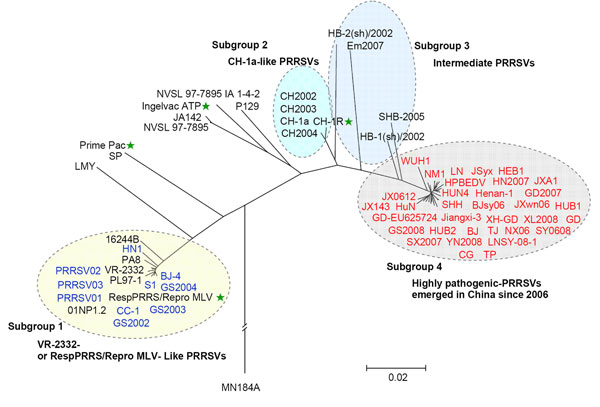Volume 16, Number 2—February 2010
Letter
Origin of Highly Pathogenic Porcine Reproductive and Respiratory Syndrome Virus, China
Appendix Figure

Appendix Figure. Phylogenetic relationships of 67 porcine reproductive and respiratory syndrome viruses (PRRSVs) based on their whole-genome sequences. The unrooted phylogenetic tree was generated by the neighbor-joining method using Molecular Evolutionary Genetics Analysis 4 (5). Bootstrap values were calculated on 1,000 replicates. The 53 isolates from China were classified into 4 subgroups (circled). Four commercially available attenuated live vaccine viruses are marked with asterisks. MLV, modified live vaccine; NVSL, National Veterinary Services Laboratories; CH, China; SP, Singapore; HN, Henan; BJ, Beijing; HB, Hebei; WUH, Wuhan; JX, Jiangxi; GD, Guangdong; LN, Liaoning; NM, Neimenggu; JS, Jiangsu; SH, Shanghai; TJ, Tianjin; SX, Shanxi; HUB, Hubei; YN, Yunnan; NX, Ningxia, GS, Gansu.
References
- Tian K, Yu X, Zhao T, Feng Y, Cao Z, Wang C, Emergence of fatal PRRSV variants: unparalleled outbreaks of atypical PRRS in China and molecular dissection of the unique hallmark. PLoS One. 2007;2:e526. DOIPubMedGoogle Scholar
- Tong GZ, Zhou YJ, Hao XF, Tian ZJ, An TQ, Qiu HJ. Highly pathogenic porcine reproductive and respiratory syndrome, China. Emerg Infect Dis. 2007;13:1434–6.PubMedGoogle Scholar
- Cha SH, Choi EJ, Park JH, Yoon SR, Song JY, Kwon JH, Molecular characterization of recent Korean porcine reproductive and respiratory syndrome (PRRS) viruses and comparison to other Asian PRRS viruses. Vet Microbiol. 2006;117:248–57. DOIPubMedGoogle Scholar
- An TQ, Zhou YJ, Liu GQ, Tian ZJ, Li J, Qiu HJ, Genetic diversity and phylogenetic analysis of glycoprotein 5 of PRRSV isolates in mainland China from 1996 to 2006: coexistence of two NA-subgenotypes with great diversity. Vet Microbiol. 2007;123:43–52. DOIPubMedGoogle Scholar
- Ma P, Shi WD, Liu YG, Cai XH, Wang HF, Wang SJ, Isolation and characterization of Chinese PRRSV isolates and sequence analysis of structural genes. [in Chinese]. Progress in Veterinary Medicine. 2008;29:43–50.
- Ostrowski M, Galeota JA, Jar AM, Platt KB, Osorio FA, Lopez OJ. Identification of neutralizing and nonneutralizing epitopes in the porcine reproductive and respiratory syndrome virus GP5 ectodomain. J Virol. 2002;76:4241–50. DOIPubMedGoogle Scholar
- Plagemann PG. The primary GP5 neutralization epitope of North American isolates of porcine reproductive and respiratory syndrome virus. Vet Immunol Immunopathol. 2004;102:263–75. DOIPubMedGoogle Scholar
- Tamura K, Dudley J, Nei M, Kumar S. MEGA4: Molecular Evolutionary Genetics Analysis (MEGA) software version 4.0. Mol Biol Evol. 2007;24:1596–9. DOIPubMedGoogle Scholar